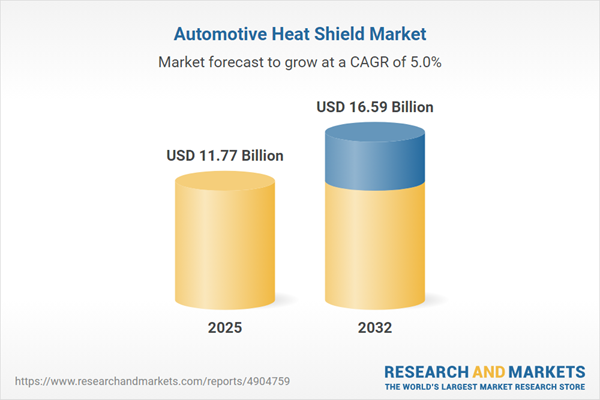Speak directly to the analyst to clarify any post sales queries you may have.
Senior automotive executives today must address stringent regulations, prioritize sustainability, and adapt to continually evolving vehicle technologies. The automotive heat shield market plays a pivotal role in supporting these priorities, offering solutions that advance compliance objectives, technological innovation, and overall operational reliability.
Market Snapshot: Automotive Heat Shield Market Overview
The automotive heat shield market is progressing, shaped by regulatory mandates and a targeted industry-wide focus on reducing environmental impact. Currently valued at USD 11.23 billion, the sector is forecast to reach USD 16.59 billion by 2032, representing a compound annual growth rate (CAGR) of 4.99%. Growth is propelled by the ongoing demand for sustainable practices and the necessity for compliance with evolving emissions standards. Companies are advancing their product development strategies, embracing advanced materials and state-of-the-art thermal management technologies to remain agile amid regulatory volatility and maintain a competitive edge.
Scope & Segmentation: Automotive Heat Shield Market
- Product Types: Single-shell and double-shell heat shields address the distinct needs of both conventional vehicles and alternative powertrain formats, providing adaptable thermal protection in line with emerging vehicle architectures.
- Material Types: Lightweight aluminum promotes fuel economy; steel offers extended corrosion resistance for greater durability; advanced composites and performance-oriented polymers enable flexible integration; ceramic laminates supply insulation suitable for high-demand settings.
- Vehicle Categories: Tailored heat shield solutions are designed for both passenger cars and commercial fleet applications, enabling manufacturers to address market-specific operational and compliance challenges.
- Applications: Heat shield technologies are integrated into body panels, engine bay firewalls, underbody structures, turbochargers, exhaust assemblies, insulation modules, and powertrain elements, providing essential protection and maintaining thermal system integrity.
- End Users: Both original equipment manufacturers (OEMs) and aftermarket suppliers are key users, deploying advanced heat shield systems to support ongoing vehicle platform updates and legacy operations.
- Regional Coverage: Market development is influenced by regulations and supply chain priorities across North America, Europe, Middle East, Africa, and Asia-Pacific. Strategic countries include the United States, Germany, China, India, and Japan, with each region contributing distinctive expertise and compliance considerations.
- Major Companies: Leading industry participants such as Autins Group Plc, BorgWarner Inc., Dana Inc., DuPont de Nemours, Continental AG, Nichias Corporation, Siemens AG, and Zircotec Ltd. are instrumental in setting technical standards and delivering localised solutions that respond to evolving customer needs.
Key Takeaways: Strategic Insights for Market Leaders
- Embedding compliance-focused processes in development and manufacturing enhances readiness for regulatory changes and ensures uninterrupted access to strategic markets.
- The shift towards electrified vehicles introduces complex heat management requirements, prompting leaders to develop new approaches for emerging powertrain systems.
- Integrating modular designs and advanced composites supports overall sustainability objectives, improves system efficiency, and contains manufacturing costs in diversified production lines.
- Combined thermal and acoustic management adds value by improving in-cabin comfort while streamlining factory processes, supporting both automaker and customer demands.
- Use of simulation tools and additive manufacturing accelerates design iteration cycles, offering greater flexibility for rapid response to shifting compliance and innovation pressures.
- Localizing supply chains and building resilient regional partnerships reduce vulnerabilities arising from global trade realignments and policy uncertainties.
Tariff Impact on Supply Chains and Costs
Forthcoming adjustments to United States tariff policy in 2025 compel manufacturers to reevaluate their supply strategies. Strengthening partnerships within regional markets and diversifying sourcing arrangements is integral to reducing exposure to sudden cost fluctuations or interruptions originating from shifts in global trade policies.
Methodology & Data Sources
This report leverages in-depth regulatory reviews, comprehensive technical benchmarking, patent landscape analysis, and market stakeholder input. Robust data modeling underpins actionable insights for senior leaders facing regulatory and technology-driven uncertainty.
Why This Report Matters for Senior Decision-Makers
- Supports cross-functional strategy development by integrating compliance, environmental, and technological considerations into procurement and planning processes.
- Empowers executive teams to manage risks proactively, identify new growth markets, and guide capital allocation as the automotive sector continues to transform.
- Enables organizations to enhance agility and build resilience in anticipation of or in reaction to evolving regulatory or market conditions.
Conclusion
Senior decision-makers receive targeted insights to inform their strategies, strengthen organizational responsiveness, and advance their competitive stance within the automotive heat shield market.
Additional Product Information:
- Purchase of this report includes 1 year online access with quarterly updates.
- This report can be updated on request. Please contact our Customer Experience team using the Ask a Question widget on our website.
Table of Contents
3. Executive Summary
4. Market Overview
7. Cumulative Impact of Artificial Intelligence 2025
List of Figures
Companies Mentioned
The companies profiled in this Automotive Heat Shield market report include:- Autins Group PLC
- Autoneum Management Ltd.
- BorgWarner Inc.
- Carcoustics International GmbH
- CERTINA Group
- Continental AG
- Dana Inc.
- DuPont de Nemours, Inc.
- Federal-Mogul LLC
- HAPPICH GmbH
- Heatshield Products, Inc.
- Keats Manufacturing Co.
- Lydall, Inc. by Unifrax
- Morgan Advanced Materials PLC by CeramTec GmbH
- Nichias Corporation
- Ningbo Huali Steel Co., Ltd.
- Nippon Steel Corporation
- SANWA PACKING INDUSTRY CO.,LTD
- Siemens AG
- Talbros Automotive Components Ltd.
- TechFlex, Inc.
- Tenneco Inc.
- UGN Inc.
- Zircotec Ltd.
Table Information
| Report Attribute | Details |
|---|---|
| No. of Pages | 185 |
| Published | November 2025 |
| Forecast Period | 2025 - 2032 |
| Estimated Market Value ( USD | $ 11.77 Billion |
| Forecasted Market Value ( USD | $ 16.59 Billion |
| Compound Annual Growth Rate | 4.9% |
| Regions Covered | Global |
| No. of Companies Mentioned | 25 |









